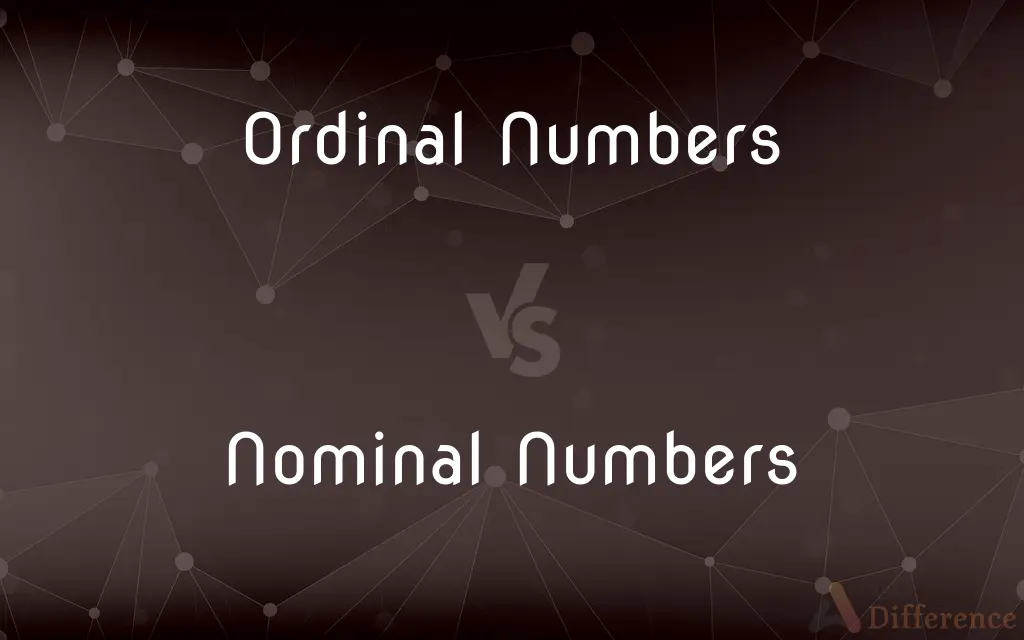Ordinal Numbers vs. Nominal Numbers — What's the Difference?
By Tayyaba Rehman & Urooj Arif — Published on February 4, 2024
Ordinal numbers indicate position or order in a sequence, while nominal numbers are used for identification or naming, without implying order.

Difference Between Ordinal Numbers and Nominal Numbers
Table of Contents
ADVERTISEMENT
Key Differences
Ordinal numbers are key in understanding sequence and order, such as first, second, and third. They are used to rank or position items, indicating their place in a series. Nominal numbers, in contrast, serve as identifiers or labels, like a jersey number in sports or a phone number, without suggesting any order or hierarchy.
Ordinal numbers are essential in data analysis for ranking and comparison purposes, as they convey a sense of hierarchy or progression. For example, ordinal numbers can describe finishing positions in a race. Nominal numbers, however, are used to categorize or distinguish items without implying any rank or sequence, such as tagging different types of products with unique codes.
In ordinal numbers, the mathematical operations like addition or subtraction don't hold meaningful results, as they represent positions, not quantities. For instance, the third place followed by the first place doesn't sum up to a fourth place. Nominal numbers, too, cannot be subjected to arithmetic operations in a way that yields meaningful insights, as they are purely for identification.
Ordinal numbers are integral in everyday scenarios, such as denoting floors in a building or grades in school, always indicating an order. Nominal numbers, on the other hand, are seen in scenarios where classification is needed without implying a ranking, such as in account numbers or vehicle license plates.
Ordinal numbers imply a relative significance or priority among the items they are associated with, indicating a gradation or level. Nominal numbers, devoid of such hierarchical connotations, are purely symbolic and used for differentiation, without suggesting any order or value comparison.
ADVERTISEMENT
Comparison Chart
Definition
Indicate position or order within a sequence.
Used for identification or naming, without order.
Purpose
To show rank, sequence, or order.
To label or categorize without implying order.
Mathematical Operations
Generally not meaningful as they represent positions.
Arithmetic operations are not applicable.
Examples
1st, 2nd, 3rd (ranks, positions)
Jersey numbers, phone numbers (labels, IDs)
Usage in Analysis
Used in rankings and comparisons.
Used to categorize or distinguish items.
Compare with Definitions
Ordinal Numbers
Used to denote order in a series or sequence.
January is the first month of the year.
Nominal Numbers
Function as unique tags or identifiers in various contexts.
My library card number is 41256.
Ordinal Numbers
Reflect the hierarchy or level within a group.
He was the second to speak at the meeting.
Nominal Numbers
Used for categorization or naming, not for ranking.
The product code is 567890.
Ordinal Numbers
Indicate specific positions or ranks in a sequence.
She finished the race in third place.
Nominal Numbers
Serve as identifiers or labels without implying order.
His jersey number is 23.
Ordinal Numbers
Convey the concept of succession or arrangement.
The fourth chapter of the book is the most interesting.
Nominal Numbers
Utilized for labeling purposes in data collection and organization.
Her employee ID is 3087.
Ordinal Numbers
Show a relative position in a structured set.
She lives on the fifth floor.
Nominal Numbers
Employed to distinguish items without suggesting hierarchy.
Each department has a unique identification number.
Common Curiosities
Can Ordinal Numbers be used for ranking?
Yes, ordinal numbers are specifically used to denote rankings or positions.
What are Nominal Numbers?
Nominal numbers are used for identification or naming, without implying any order.
Are Nominal Numbers used in mathematical operations?
No, nominal numbers are not suitable for arithmetic operations as they represent labels.
Is "yes" or "no" considered Nominal Data?
Yes, "yes" and "no" are examples of Nominal Data, used to categorize responses as either positive or negative.
What are Ordinal Numbers?
Ordinal numbers indicate positions or ranks in a sequence.
Can you provide an example of using Nominal Numbers in a sentence?
apples, oranges, and bananas, representing Nominal Categories."
Do Ordinal Numbers have decimal fractions?
Ordinal Numbers are usually whole numbers, and they do not have decimal fractions.
Are Nominal Numbers finite or infinite?
Nominal Numbers are typically finite, representing distinct categories or labels within a specific context.
How do Ordinal and Nominal Numbers differ in purpose?
Ordinal numbers denote order or rank, while nominal numbers categorize or identify.
Are there exceptions in the way Ordinal Numbers are written?
Some Ordinal Numbers, like "first," "second," and "third," have irregular forms, but most follow a standard pattern (e.g., adding "th" to the cardinal number).
Can Nominal Numbers indicate a sequence?
No, nominal numbers do not imply any sequence or order.
Can you give an example of using Ordinal Numbers in a sentence?
Certainly! "She finished in second place in the race."
What is the significance of "zero" as an Ordinal Number?
"Zero" is not considered an Ordinal Number because it does not indicate a position or rank.
Share Your Discovery

Previous Comparison
Palmetto Bug vs. Cockroach
Next Comparison
Canola Oil vs. Safflower OilAuthor Spotlight
Written by
Tayyaba RehmanTayyaba Rehman is a distinguished writer, currently serving as a primary contributor to askdifference.com. As a researcher in semantics and etymology, Tayyaba's passion for the complexity of languages and their distinctions has found a perfect home on the platform. Tayyaba delves into the intricacies of language, distinguishing between commonly confused words and phrases, thereby providing clarity for readers worldwide.
Co-written by
Urooj ArifUrooj is a skilled content writer at Ask Difference, known for her exceptional ability to simplify complex topics into engaging and informative content. With a passion for research and a flair for clear, concise writing, she consistently delivers articles that resonate with our diverse audience.











































